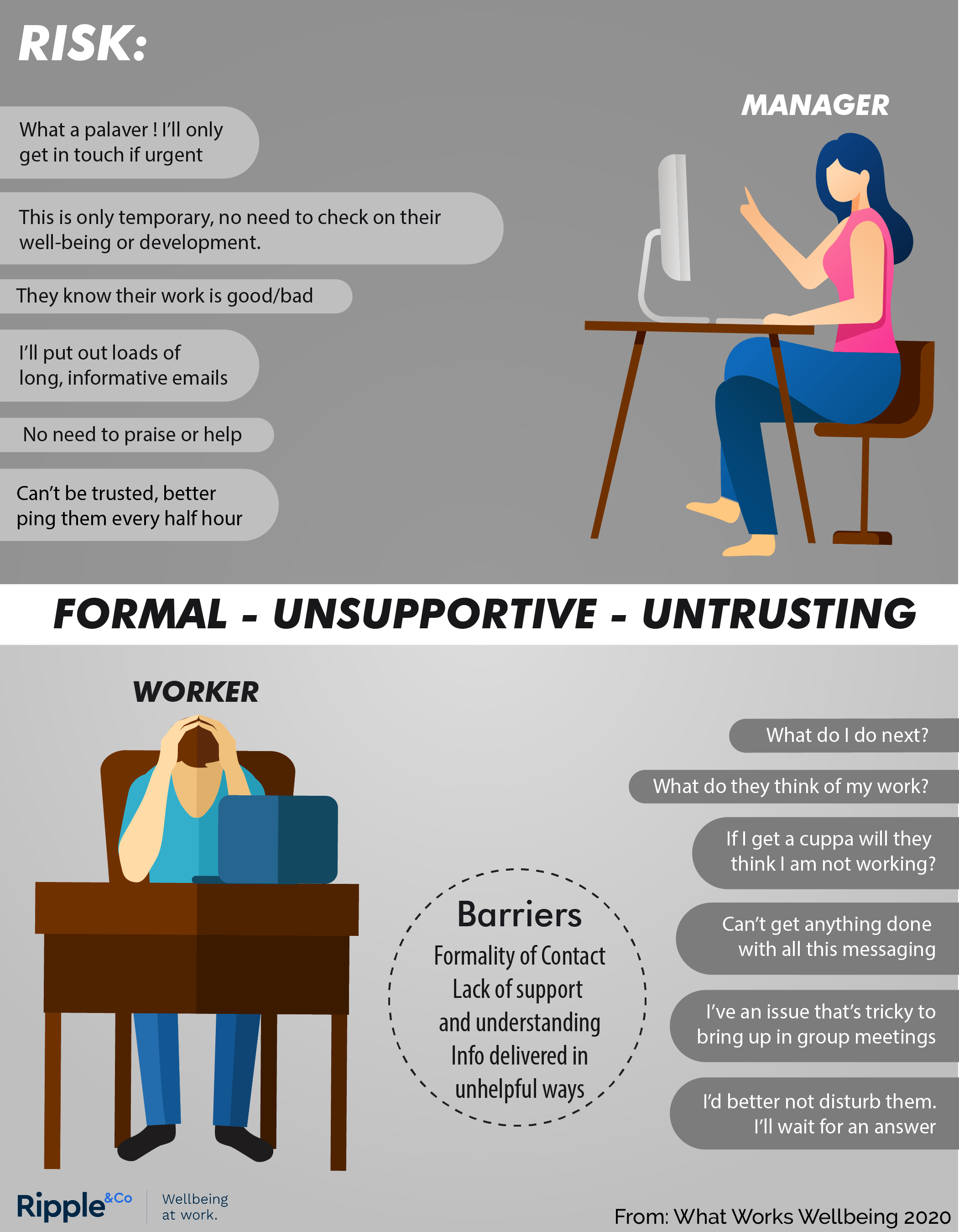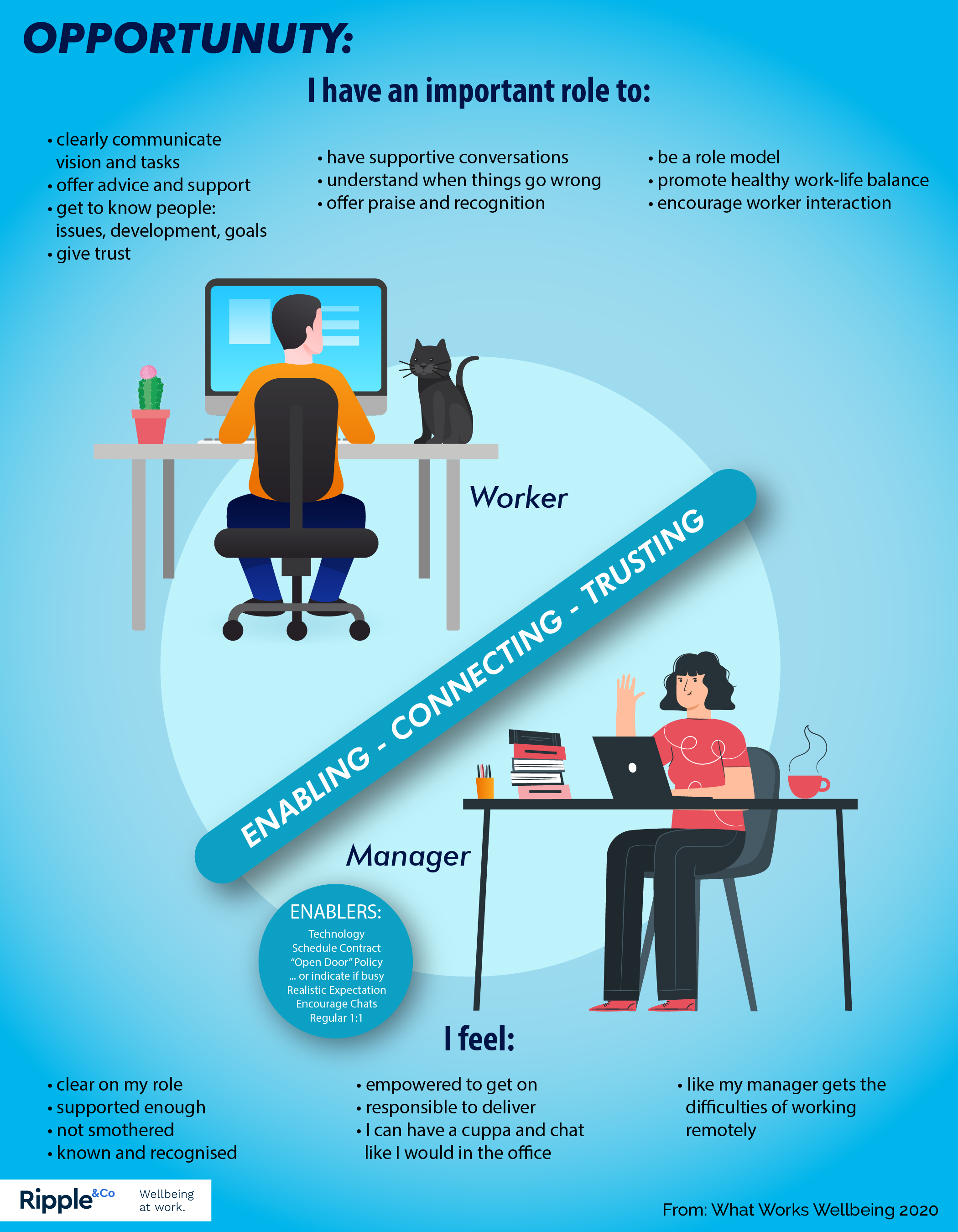Managing Remotely
Research tells us that relationships are the most significant driver of job satisfaction, and the one that an employee has with their manager is the most important relationship of all.
70% of an employee’s motivation comes from their manager.
Good management is critical to workplace wellbeing and is about relationships and communication. Your team need support, recognition and feedback, to feel that you understand the challenges of remote working.
COMMUNICATION IS KING
When and how
Of course, communication needs, styles and methods have changed. You need to plan how and when to communicate with your team far more, rather than having the ease of regular and spontaneous communication in an ordinary office setting.
With less face-to-face time with your team, it makes it harder to look after their wellbeing and psychological safety. It’s more difficult to get to know people’s issues, understand the way they work, be able to offer immediate advice or role model good behaviours. Critically, employees suffer from not being able to ask questions informally or being able to rely on social support from their colleagues. Not being in the same room means you don't have extra information from body language or tone to get the sense of what people are thinking or feeling. Home in on what’s not being said and ask questions to clarify.
Since everyone is now juggling a multitude of roles that have all been thrown together, it’s worth asking members of your team the most appropriate way to get in touch, perhaps how much contact they would prefer and what time of day works best. Be clear about mutual expectations and trust your team to get on without micromanaging. Focus on results rather than activity.
Plan your communication
The current situation gives you as a manager the opportunity to turn the risks of managing remote employees into an opportunity to build your management skills for the future. If you start to think more about the wide range of different reasons you interact with your team (task setting and assistance, wellbeing and safety support, feedback and personal development, social interaction to build good working relationships) then you can schedule in technology-enabled contact time to address each aspect. Although getting this balance right may take some time, consider that you probably do all of these already, you just haven’t had to actively and visibly schedule them in before.
Two -way communication
Make sure that your team know how to get hold of you should they need to and what to expect from you in terms of response rates, which may be very different now depending on the juggle you have at home. Encourage them to reach out to you and the team to share updates or learnings from other meetings and projects. Opportunities to pick up information in passing are more limited when working remotely.
Making it personal
It’s also worth setting regular opportunities for the team to chat without it being work focused. This could be a weekly beer and chat on a Friday or a daily morning coffee check in. It’s important to keep at least one of these purely social as a way to give the team a chance to feel connected and offer peer to peer support, as they would do in the physical environment of the office.
Turn up the positivity
With so much noise in the media it’s easy to get drawn down into negativity. Help your time avoid this downward spiral and instead convey calm and a sense of perspective about ‘what this means to us’ and actively seek ways to de-escalate any temptations to be pulled into negative discussion. Perhaps you know the people in your team whose ‘half empty’ way of looking at things will need more management at this time. Seek them out and help reframe their thinking by offering a positive, alternative way at looking at things.
The bigger picture
Help your team stay connected to the vision and purpose, as well as how their work is contributing to it. Re-emphasising your priorities right now will help keep them focussed. Celebrate everyday success and shift any temptation to move into ‘survival mode’.
It’s okay not to be okay
The British Psychological Society recommends that managers actively normalise some of the psychological responses your employees may be having to the lockdown. There is already significant stigma around mental ill health which prevents people from disclosing how they feel and subsequently receiving the support they need. If you’re able to encourage your team to talk about how they feel, you will more easily be able to spot the signs of potential mental ill health and signpost them to support services (either your Employee Assistance Programme of Able Futures (a programme offered and funded by DWP). It’s worth communicating these services to them anyway, so they can access them should they need to.
Take care of yourself
There are likely a whole host of items on your to do list that aren’t usually there, and you’re probably adjusting to a new work environment too. It’s important to look after yourself too - put your own oxygen mask on first. Prioritising optimal performance is the only thing that you can put at the top of your to do list every single day and it have a positive impact on the rest of the things on your list. If you’re feeling well, then you are more likely going to be able to support your team when they need you. You want them to return to work feeling that they were supported and that their wellbeing was a genuine concern during the crisis. Since this situation may continue for some time, it is crucial to be aware of the challenges of managing remotely and take steps to make it a success, with benefits for the health and productivity of both you and the team.






